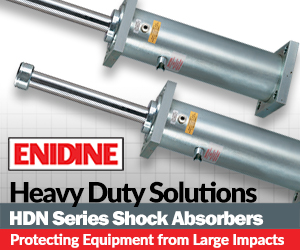Accelerometer Selection and Mounting Considerations for Motor Condition Monitoring
Both mechanical and electrical faults can cause errant vibration in DC and nonsynchronous AC motors. These faults can typically be classified into a low frequency band (0.3 to 50 times running speed) or a high frequency band (500 Hz to 20+ kHz).
In order for a sensor to detect both low and high frequency vibration that might be present, the frequency response of the sensor and its mounting methodology must be examined, as resonant frequency and mass have an inverse relationship while resonant frequency and stiffness have a direct relationship. To achieve high frequency measurements, an accelerometer must be as small as possible and have as stiff of a mounting methodology as possible. Each of these two factors are explored in detail in the following sections.
How to Choose the Appropriate Accelerometer
Sensor manufacturers continue to make smaller and smaller accelerometers in order to satisfy customers’ requests for sensors capable of high frequency measurements. This effort is challenging, as they must balance the small size with the need for a rugged sensor that can withstand the harsh environments to which they are usually subjected.
Most industrial customers require:
Robust Housing: In the world of industrial accelerometers, the robustness of the sensor’s housing is not determined by one single factor. It is determined by the housing material, the level of sealedness that the housing provides and the electrical isolation of the housing. Most industrial accelerometer housings are 304 or 316 stainless steel and hermetically sealed in order to withstand chemical exposure and wide operating temperature ranges. A case-isolated housing allows an accelerometer to be mounted on equipment with poor electrical grounding without running the risk of signal contamination. The isolation is typically achieved with the use of a Faraday cage, a continuous enclosure around the sensor’s electronics to repel noise.
Rugged Connectors: Connectors must be able to withstand repeated use in harsh conditions. Military-style connectors are preferred as they can withstand extreme conditions, as can their mating cables.
Choosing the Appropriate Mounting Method
There are several common methodologies used for vibration sensor mounting. To explore the effect of different attachment schemes, an accelerometer was selected to run frequency response curves from 100 to 50,000 Hz with various means of attaching the accelerometer to the surface. The frequency response curve for the accelerometer is presented in Figure 1. The mounting schemes include a stud mount with grease, a stud mount on a flat smooth surface, a rare-earth flat magnet on a flat smooth mounting pad, a two-pole magnet on a rough curved surface and a two-pole magnet on a smooth curved surface.
The objective in presenting these response curves is to illustrate how the frequency response differs with different mounting methods of the sensor. The variation of response begins to deviate for frequencies exceeding 2 kHz for the different attaching schemes. For the low frequency of 0.5 to 2 kHz, all attaching schemes demonstrated in Figure 1 are essentially the same. For the frequency range of 10 to 20+ kHz, there are significant differences. In particular, the use of the two-pole magnet on a curved surface would miss many impacting, fluting and friction problems. In contrast, attaching the sensor using a flat magnet set on a smooth flat surface would catch those types of problems. The optimum means of attaching the sensor would be using stud mount on a smooth flat surface.
From the data presented in Figure 1, it is concluded that the stud-mounted sensor provides useful data out to the 30-40 kHz range. The flat magnet attached to a flat smooth pad provides
acceptable data out to the 15 kHz range. The dual rail magnet on a curved surface provides detectability out to the 9 kHz range. The large resonant feature in the dual rail magnet on a curved surface in the 6 kHz range may be problematic for motors having rotor bar problems with a rotor bar pass frequency in the proximity of 3 kHz (it would make the second harmonic at 6 kHz artificially large). A large second harmonic of the rotor bar pass frequency contributes to the fault assessment of rotor bars.
In order to reliably catch faults generated by impacting, friction, fluting and rotor bars, the mounting scheme of a dual rail magnet on a curved surface is not acceptable. It will only provide accurate results for faults and vibrations less than 3 kHz. Attaching the sensor to a smooth surface via a flat magnet does provide an acceptable result, but the use of a sensor that has been stud mounted to a dry clean smooth surface is the best.






![EMR_AMS-Asset-Monitor-banner_300x600_MW[62]OCT EMR_AMS-Asset-Monitor-banner_300x600_MW[62]OCT](/var/ezwebin_site/storage/images/media/images/emr_ams-asset-monitor-banner_300x600_mw-62-oct/79406-1-eng-GB/EMR_AMS-Asset-Monitor-banner_300x600_MW-62-OCT.png)



